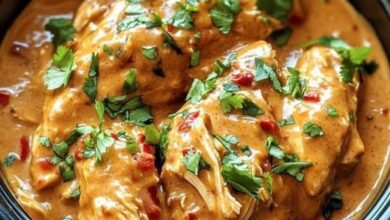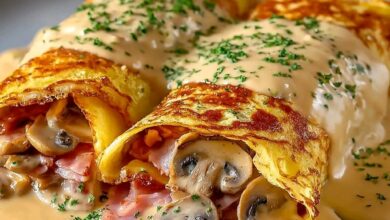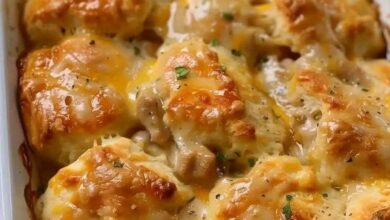Classic Vanilla Butter Cake with a decadent Buttermilk Sauce

Of course! Here is a comprehensive, “big” recipe for a Classic Vanilla Butter Cake with a decadent Buttermilk Sauce, presented with all the elements you requested.
Introduction
Welcome to the pinnacle of home baking comfort: the Classic Vanilla Butter Cake. This isn’t just a cake; it’s a warm, golden-hued emblem of celebration and everyday joy. Its texture is phenomenally tender and moist, with a tight, soft crumb that melts in your mouth. The crowning glory? A warm, buttery, and tangy Buttermilk Sauce that is poured over the warm cake, seeping into its very pores and creating a sublime, sticky-sweet crust on top. This recipe is a testament to the magic of simple, quality ingredients coming together to create something truly extraordinary.
History & Formation
The vanilla butter cake is a descendant of the classic English pound cake, which traditionally used a pound each of butter, sugar, eggs, and flour. Over time, recipes evolved to create a lighter, more leavened cake. The introduction of baking powder and soda in the 19th century allowed for this, giving rise to the modern butter cake.
The “formation” of this particular cake’s character comes from two key techniques:
1. The Creaming Method: Beating butter and sugar together traps air bubbles, which expand during baking, contributing to a light and fluffy structure.
2. The Buttermilk Soak: The use of buttermilk, both in the batter and in the sauce, is a Southern US baking tradition. Buttermilk tenderizes the gluten in the flour, resulting in an exceptionally moist cake. Pouring a hot buttermilk sauce over the baked cake is a classic technique seen in recipes like “Buttermilk Pie” or “Pudding Cakes,” transforming a simple cake into a rich, spoonable dessert.
Ingredients
For the Vanilla Butter Cake:
· 2 cups (250g) All-Purpose Flour
· 1 ½ cups (300g) Granulated Sugar
· 1 cup (2 sticks or 226g) Unsalted Butter, softened at room temperature
· 4 large Eggs, at room temperature
· 1 cup (240ml) Buttermilk, at room temperature
· 2 tsp Baking Powder
· ½ tsp Baking Soda
· ½ tsp Salt
· 2 tsp Pure Vanilla Extract
For the Buttermilk Sauce:
· ½ cup (1 stick or 113g) Unsalted Butter
· 1 cup (200g) Granulated Sugar
· ½ cup (120ml) Buttermilk
· 1 tbsp Light Corn Syrup (or honey)
· 1 tsp Pure Vanilla Extract
· ½ tsp Baking Soda
Methods & Instructions
Method: The Creaming Method
This method is crucial for building the cake’s structure and volume. The goal is to beat the butter and sugar until it becomes pale, light, and fluffy. This incorporates tiny air bubbles that will expand in the oven, giving the cake its rise and soft texture.
Instructions for the Cake:
1. Prepare: Preheat your oven to 325°F (165°C). Grease and flour a 9×13 inch baking pan or bundt pan.
2. Combine Dry Ingredients: In a medium bowl, whisk together the flour, baking powder, baking soda, and salt. This ensures the leavening agents are evenly distributed.
3. Cream Butter and Sugar: In a large bowl, using an electric mixer, beat the softened butter and sugar together on medium-high speed for 3-5 minutes, until the mixture is very light, pale yellow, and fluffy. Scrape down the sides of the bowl as needed.
4. Incorporate Eggs: Add the eggs one at a time, beating well after each addition until the yolk is fully incorporated. Mix in the vanilla extract.
5. Combine Wet and Dry: Reduce the mixer speed to low. Add the dry ingredients to the butter mixture in three parts, alternating with the buttermilk in two parts, beginning and ending with the dry ingredients. Mix only until just combined. Do not overmix.
6. Bake: Pour the batter into the prepared pan and smooth the top. Bake for 45-55 minutes (or 50-60 minutes for a bundt pan), or until a wooden skewer inserted into the center comes out clean.
Method: The Stovetop Sauce & Soak
While the cake is baking, prepare the sauce. This is a simple stovetop method that creates a rich, caramel-like liquid that will be absorbed by the warm cake.
Instructions for the Sauce & Finish:
1. Combine Sauce Ingredients: About 10 minutes before the cake is done, combine the butter, sugar, buttermilk, and corn syrup in a medium saucepan.
2. Cook the Sauce: Bring the mixture to a boil over medium heat, stirring constantly. Once boiling, reduce heat and let it simmer for 3-4 minutes without stirring.
3. Finish the Sauce: Remove the saucepan from the heat and immediately stir in the vanilla extract and baking soda. The baking soda will cause the sauce to foam up dramatically—this is normal and creates a light, porous texture in the finished glaze.
4. The Grand Finale – The Soak: As soon as the cake comes out of the oven, use a skewer to poke holes all over the top. Slowly and evenly, pour the hot buttermilk sauce over the entire warm cake.
5. Cool and Serve: Allow the cake to cool completely in the pan on a wire rack. This resting period is essential for the sauce to fully absorb and set. Serve directly from the pan.
Nutrition & Benefits
While this is undoubtedly a decadent dessert, understanding its components is valuable.
· Energy Source: The carbohydrates from flour and sugar provide immediate and sustained energy.
· Protein & Fat: Eggs and butter contribute protein and fat, which aid in satiety and help build cells.
· Calcium & Probiotics: Buttermilk offers a good source of calcium for bone health and contains cultures that can be beneficial for gut health.
· Moderation is Key: This cake is rich in calories, sugar, and saturated fat. Enjoying it as an occasional treat within a balanced diet is the best approach. The portion size from a 9×13 pan allows for many servings, promoting sharing and moderation.
For the Lovers
This cake is a versatile crowd-pleaser, but here’s how to tailor it for different “lovers”:
· The Fruit Lover: Serve with a side of fresh macerated berries (strawberries, raspberries) or a warm berry compote. The tartness of the fruit cuts beautifully through the cake’s richness.
· The Chocolate Lover: Fold 1 cup of chocolate chips into the batter or drizzle the finished cake with a dark chocolate ganache in addition to the buttermilk sauce.
· The Nut Lover: Sprinkle ¾ cup of toasted pecans or walnuts over the cake right after you pour the buttermilk sauce. They will toast further and add a wonderful crunch.
· The Gourmet Lover: Infuse the buttermilk sauce with a sprig of fresh lavender or a few crushed cardamom pods while it simmers, straining them out before adding the vanilla and baking soda.
Conclusion
The Classic Vanilla Butter Cake with Buttermilk Sauce is more than the sum of its parts. It is a masterpiece of texture and flavor, where the simple, comforting taste of vanilla and butter is elevated to new heights by a transformative, tangy-sweet sauce. The process—from the careful creaming of butter and sugar to the dramatic foaming of the sauce—is a rewarding ritual that results in a dessert capable of turning an ordinary day into an occasion. It’s a recipe that asks for little more than pantry staples but gives back immeasurably in warmth, nostalgia, and pure, unadulterated delight. This is a cake you will make for those you love, and it will quickly become a recipe they request for years to come.



